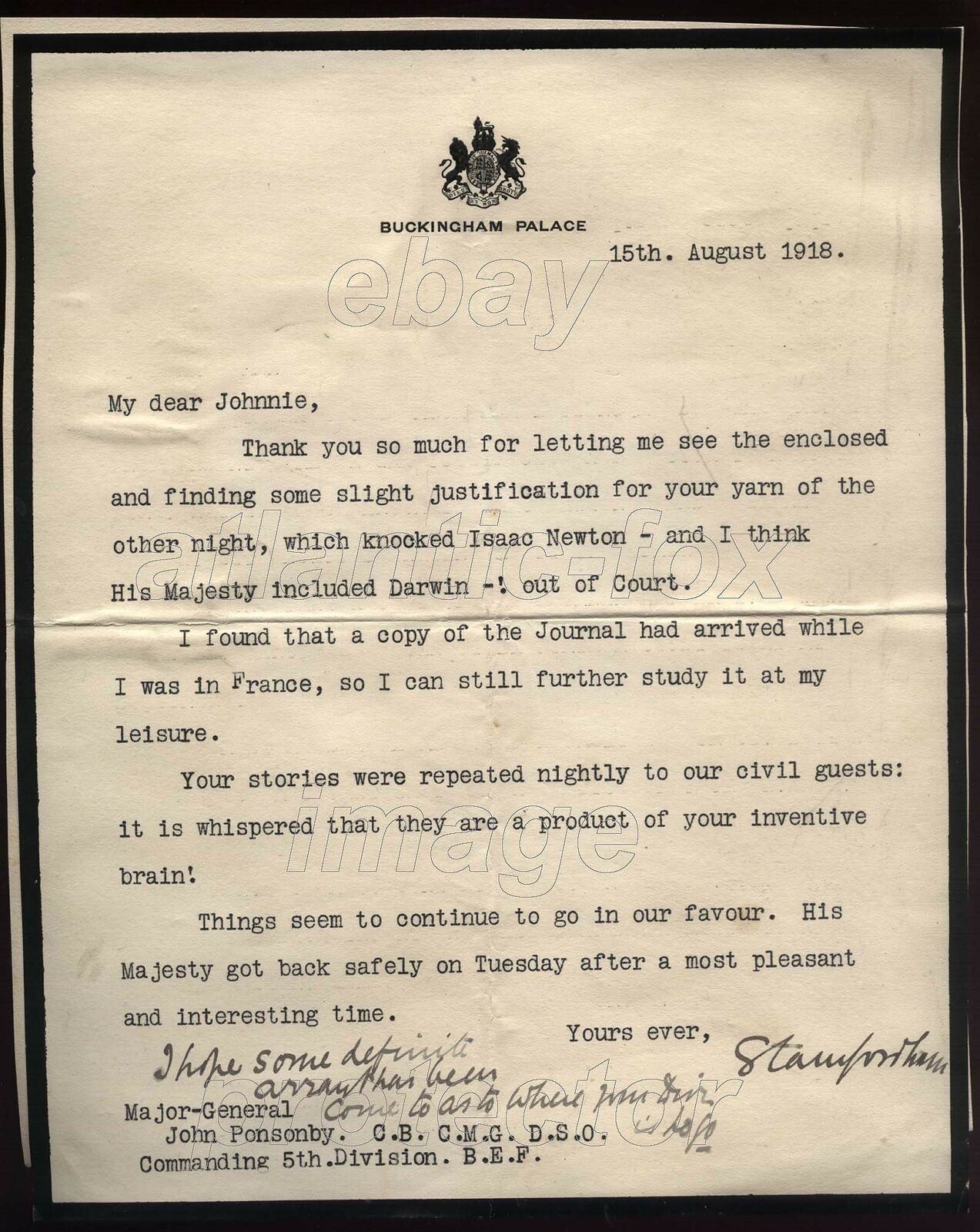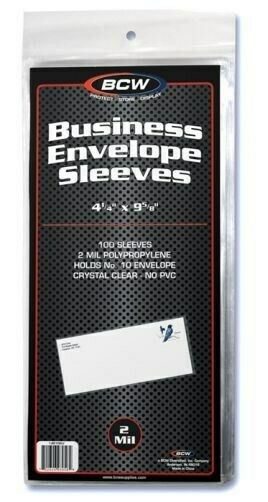-40%
WWI-BUCKINGHAM PALACE - Lord Stamfordham, Kings P/Secretary to General Ponsonby
$ 479.87
- Description
- Size Guide
Description
WWI-BUCKINGHAM PALACE - Lord Stamfordham, Kings P/Secretary to General PonsonbyThis product data sheet is originally written in English.
WWI-BUCKINGHAM PALACE - Lord Stamfordham, the Kings Private Secretary a fine typed letter to Major General John Ponsonby commanding the 5th Division of the British Army, relating to his enclosed letters and "Yarn" enjoyed in the Kings Company, and in which he mentions the King as just having returned from the Visit to the troops in France. I manuscript note by Stamfordham reads " I hope some definate arrangement has been come to to as to where your Division is to go" and dated 15th August 1918.
Arthur Bigge, 1st Baron Stamfordham
Lieutenant-Colonel Arthur John Bigge, 1st Baron Stamfordham, GCB, GCIE, GCVO, KCSI, KCMG, ISO, PC (18 June 1849 – 31 March 1931)
was a British Army officer and courtier. He was Private Secretary to Queen Victoria during the last few years of her reign, and to George V during most of his reign. He was the maternal grandfather of Lord Adeane, Private Secretary to Elizabeth II from 1953 to 1972
Bigge was the son of John Frederic Bigge (1814–1885) Vicar of Stamfordham, Northumberland and the grandson of Charles William Bigge (1773–1849) of Benton House, Little Benton, Newcastle on Tyne and Linden Hall, Longhorsley, Northumberland, High Sheriff of Northumberland and a prominent merchant and banker in Newcastle on Tyne. He was educated at Rossall School and the Royal Military Academy and was commissioned into the Royal Artillery in 1869
Between 1878 and 1879, Bigge fought in the Anglo-Zulu War, as is known from his mentions in despatches. In 1880, he was summoned to Balmoral Castle by Queen Victoria for giving an explanation on the Prince Imperial's death in the Zulu War. Before he was appointed as a Private Secretary, he had served as a groom-in-waiting and assistant private secretary to Queen Victoria. In 1881, he was appointed equerry-in-ordinary.
Bigge was appointed Private Secretary to Queen Victoria in 1895 and served until her death in January 1901. A couple of months later, he was appointed Private Secretary to her grandson, the Duke of Cornwall and York (appointed Prince of Wales later the same year). He continued to serve as such on the Prince´s accession to the throne as King George V in 1910, serving until his own death in 1931. As Private Secretary to the sovereign he was sworn of the Privy Council in 1910 and elevated to the peerage as Baron Stamfordham, of Stamfordham in the County of Northumberland, in 1911.
Bigge seemed to have an influence over King George and was one of those who supported the King's decision to adopt Windsor as the family name because of the keen anti-German feelings, which were arising during the World War I. On 17 July 1917 King George V "issued a proclamation declaring “The Name of Windsor is to be borne by His Royal House and Family and Relinquishing the Use of All German Titles and Dignities.”; persuading the King to deny asylum to Tsar Nicholas II and his family, who were thus forced to remain in Russia and who were murdered by the Bolsheviks; and interpreting the King's response "Bugger Bognor" as assent to the renaming of Bognor as Bognor Regis. He introduced the Duke of York (later King George VI) to Lionel Logue, who became the Duke's speech therapist.
Bigge married Constance Neville (d. 1922) in 1881: they had a son and two daughters. Their son, Captain The Hon. John Neville Bigge (b. 1887), was killed in action near Festubert on 15 May 1915 whilst serving with the 1st Bn. King's Royal Rifle Corps. He is commemorated on Le Touret Memorial. A daughter, the Honourable Victoria Eugenie, married Captain Henry Robert Augustus Adeane. She was the mother of Michael Adeane, Baron Adeane, Private Secretary to Elizabeth II from 1953 to 1972.
Lord Stamfordham died, still in office, at St James's Palace on 31 March 1931, aged 81, when the barony became extinct.
AUGUST 1918
The King, in Field Marshal's uniform and unaccompanied by other members of the Royal family, arrives at Calais on HMS Whirlwind on 5 August. Three days later he inspects British and US pilots of RAF 1st Brigade at Izel-les-Hameaux with General Plumer. On 6 August he reviews US 30th Division at Biezen (Belgium) with their commander, Major-General Lewis. At Blendecques he presents the Victoria Cross to Captain J T Crowe of 2nd Battalion, Worcestershire Regiment, Second-Lieutenant C L Knox of 150th Field Company, Royal Engineers and Sergeant C L Train of 2/14th Battalion, London Regiment (2nd London Scottish), and the GCB to General Plumer. On 7 August at Bouin he watches trees being felled by Number 365 Forestry Company, Royal Engineers. He meets Field Marshal Haig at his headquarters, Château de Beaurepaire, Montreuil, on 7 August with President Poincaré, and inspects the honour guard of Royal Guernsey Light Infantry. Back at Izel-les-Hameaux on 8 August, with General Horne, he meets pilots of 203 Squadron RAF beside their Sopwith Camels. At Sautrecourt on 10 August he watches a tank and Infantry demonstration with Brigadier-General Elles, and at Mametz on the same day meets Colonel A Barbosa, commanding 1st Portuguese Division. At Cassel on 11 August he watches a marchpast by Second Army troops, including US forces, and gives Americans of 30th Division some British decorations (the caption identification of General Rawlinson is not correct). At Australian Corps headquarters, Bertangles Château, on 12 August, he knights General Sir John Monash, the Corps commander, and Major-General M W O'Keeffe, Fourth Army Director of Medical Services. Finally he leaves Calais on board HMS Whirlwind on 13 August.
Fresh to the Market Place, from Major-General Sir John Ponsonby's Collection
For more from this collection see our shop category for SIR HENRY & JOHN PONSONBY COLLECTION
John Ponsonby (British Army officer)From Wikipedia, the free encyclopedia
Major-General Sir John Ponsonby KCB CMG DSO (25 March 1866 – 26 March 1952) was a British Army officer who commanded 5th Division during World War I
Born the son of Sir Henry Ponsonby (Queen Victoria's Private Secretary), his Mother Hon. Mary Elizabeth Ponsonby, Maid of Honour to Queen Victoria and a daughter of John Crocker Bulteel.
His brothers were Frederick Ponsonby, ( Assistant Private Secretary to Edward VII & GV), and Arthur Augustus William Harry Ponsonby, 1st Baron Ponsonby of Shulbrede, (British politician, writer, and social activist).
Sir John was educated at Eton College, He was gazetted to the Royal Irish Rifles 16 November 1887, and to the Coldstream Guards 15 August 1888, becoming Lieutenant 29 June 1891. He was ADC to the Governor and Commander-in-Chief, South Africa, 10 August 1891 to 30 January 1895; served in operations in Matabeleland (Medal); was promoted to Captain 7 September 1898, and in that year served in Uganda (Medal), and again in 1899, during the operations against Kabarega (clasp). Captain Ponsonby served in the South African War, 1899-1902, on special service with the Rhodesian Field Force, 19 February 1900 to 7 July 1901. He was Adjutant, 5th New Zealand Regiment, 8 June 1900 to 1 January 1901; afterwards in command 1 January to 18 January 1901. From February to May 1900, be was employed with Mounted Infantry, and he took part in operations in the Transvaal, west of Pretoria, from July to 29 November 1900; operations in the Transvaal, February to June 1901; operations in Cape Colony, February to 31 May 1902. He was mentioned in Despatches [London Gazette, 10 September 1901]; received the Queen's Medal with four clasps, the King's Medal with two clasps, and was created a Companion of the Distinguished Service Order [London Gazette, 27 September 1901]: "John Ponsonby, Captain, Coldstream Guards. In recognition of services during the operations in South Africa". The Insignia were presented by the King 27 October 1901. He was promoted to Major 23 January 1904, and commanded the Guards' Depot 1 March 1905 to 28 February 1907. He became Lieutenant Colonel 28 October 1913.
Lieutenant Colonel Ponsonby served in the European War, 1914—18; Landed in France 13th August 1914 in charge of 1st Coldstream Guards,Wounded 15th September & returned to unit 21st November. commanded the 2nd Guards Brigade, BEF, 26 August 1915 to 19 November 1916: was given the Brevet of Colonel 1 January 1916; commanded the Special Reserve Infantry Brigade 28 November 1916 to 7 March 1917; commanded the 21st Infantry Brigade, BEF, 8 March to 20 March 1917; became Colonel 20 March 1917; commanded the 2nd Guards Brigade, British Armies in France, 21 March to 21 August 1917; commanded the 40th Division, British Armies in France, 22 August 1917 to 3 July 1918; subsequently commanded the 5th Division, British Armies in France, 4 July 1918 to 1 April 1919; was promoted to Major General 1 January 1919. He was mentioned in Despatches; created a CMG in 1915, a CB in 1918, and was given the Brevet of Colonel.
He went on to become General Officer Commanding 5th Division remaining in that role until the end of the War. After the War he became General Officer Commanding the Madras District of India. He retired in 1928.
He lived at Haile Hall near Beckermet in Cumbria
:
Powered by SixBit's eCommerce Solution
WWI-BUCKINGHAM PALACE - Lord Stamfordham, the Kings Private Secretary a fine typed letter to Major General John Ponsonby commanding the 5th Division of the British Army, relating to his enclosed letters and "Yarn" enjoyed in the Kings Company, and in which he mentions the King as just having returned from the Visit to the troops in France. I manuscript note by Stamfordham reads " I hope some definate arrangement has been come to to as to where your Division is to go" and dated 15th August 1918. Arthur Bigge, 1st Baron Stamfordham Lieutenant-Colonel Arthur John Bigge, 1st Baron Stamfordham, GCB, GCIE, GCVO, KCSI, KCMG, ISO, PC (18 June 1849 – 31 March 1931) was a British Army officer and courtier. He was Private Secretary to Queen Victoria during the last few years of her reign, and to Ge
EAN
Does Not apply
Country
England
Estate or House name
Buckingham Palace
England County
Middlesex
City/Town/Village/Place
London
Family Surname
Bigge
Subject type
WWI
Theme
Military
Era
1901-1950
Addressed to
Major-General John Ponsonby
Theme 2
Kings Visit to France
Letter From
Lord Stamfordham
Document Type
Original Typed & Manuscript Letter
Year of Issue
1918









